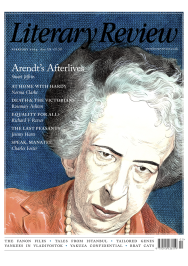Caroline Moorehead
The Drowned & the Saved
I Seek a Kind Person: My Father, Seven Children and the Adverts that Helped Them Escape the Holocaust
By Julian Borger
John Murray 304pp £20
Cold Crematorium: Reporting from the Land of Auschwitz
By József Debreczeni (Translated from Hungarian by Paul Olchváry)
Jonathan Cape 256pp £16.99
Off the main hall of Vienna’s Westbahnhof there is a statue in bronze of a small Jewish boy sitting on a suitcase. He has a straight fringe and an anxious expression and one of his socks is falling down. Westbahnhof is the station from which Jewish children left on the Kindertransport for England between 1938 and 1939. It was also here that Julian Borger’s father, Robert, was put on a train to safety at the age of eleven. Robert was not a Kindertransport child. Rather, his parents had placed an advertisement in the Manchester Guardian on 3 August 1938 asking for a ‘kind person’ to take in and educate their ‘intelligent boy’. It was answered by Nancy and Reg Bingley in Caernarfon, Wales, who sent a smiling photograph of themselves attached to their letter of welcome.
Robert killed himself in 1983, leaving a wife and four children. ‘To be pathetic’, he had written in his suicide note, ‘is the ultimate sin.’ A lecturer in psychology at Brunel University and prone to depression, he had been passed over for a professorship he believed would be his. His son Julian grew up to be a much-respected foreign correspondent and Pulitzer Prize winner. Discovering the advertisement in the Manchester Guardian was, he writes, like receiving a ‘telegram’ from another age. It sent him off on a quest to make sense of his father’s life.
Robert was not the only child to be advertised that day, alongside radio programmes, musical instruments and houses for sale. Also advertised were fourteen-year-old George Mandler and Gertrude Batscha, ‘well-mannered, able to help in any household work’, and ‘two very modest’ sisters, ‘half orphans, well trained’. Using his skills as

Sign Up to our newsletter
Receive free articles, highlights from the archive, news, details of prizes, and much more.@Lit_Review
Follow Literary Review on Twitter
Twitter Feed
It wasn’t until 1825 that Pepys’s diary became available for the first time. How it was eventually decrypted and published is a story of subterfuge and duplicity.
Kate Loveman tells the tale.
Kate Loveman - Publishing Pepys
Kate Loveman: Publishing Pepys
literaryreview.co.uk
Arthur Christopher Benson was a pillar of the Edwardian establishment. He was supremely well connected. As his newly published diaries reveal, he was also riotously indiscreet.
Piers Brendon compares Benson’s journals to others from the 20th century.
Piers Brendon - Land of Dopes & Tories
Piers Brendon: Land of Dopes & Tories - The Benson Diaries: Selections from the Diary of Arthur Christopher Benson by Eamon Duffy & Ronald Hyam (edd)
literaryreview.co.uk
Of the siblings Gwen and Augustus John, it is Augustus who has commanded most attention from collectors and connoisseurs.
Was he really the finer artist, asks Tanya Harrod, or is it time Gwen emerged from her brother’s shadow?
Tanya Harrod - Cut from the Same Canvas
Tanya Harrod: Cut from the Same Canvas - Artists, Siblings, Visionaries: The Lives and Loves of Gwen and Augustus John by Judith Mackrell
literaryreview.co.uk